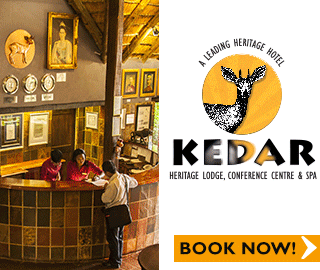

The Orngesherr Maasai Ceremony
BY CHRISTINE SIAMANTA KINORI | 31 JULY 2017 16:57
It is dusk and the sun is slowly setting but you can still clearly see the peaks of Mt.Kilimanjaro. It has been a sunny day and I have been traveling by bike to get to the emanyatta where the Orngesherr ( Maasai age-mate ceremony) will be held. It's in the remote region a small town called Loitoktok at the border of Kenya and Tanzania. It was a scenic journey but only a bike can manage to get through the narrow murram roads. Its literally a connection of narrow roads in the middle of nowhere. On our way we were lucky enough to spot an elephant's footprint. The Maasai in this region are known to living peacefully with the wild animals.
This is a highly anticipated ceremony in the life of a Maasai man .It is performed to mark the retirement from moranism to elder hood in the Maasai community. Today’s festival is in honor of the Ilkiponi age set. It is a ceremony where one is now considered grown enough to be able to make important decision as a wise man in the family. The age set is an integral structure in the African community. In the Maasai community it is the central unit of the society. It is only relevant to the men since women don’t have their own age set and are only recognized by their husbands' age-set.
I can feel the excitement from the people as they move around doing different preparations. Water is being fetched from the river , knives are being sharpened. The children are running up and down doing errands they have been ordered to do. The men in the age set seem more thrilled than the rest. They have been waiting for this celebration for twenty two years. In this ceremony they get a new status in the community, they will become junior elders. It is their final initiation phase and they shall be welcomed into a new respected position in the society.
Twenty two years ago ,they had a ceremony that ushered them from boyhood to manhood. In that ceremony they were ushered into moranism. They become warriors of the tribe. They twisted and dyed their hair red.The ceremony usually happens after circumcision. They were not allowed to eat alone or take any fatty meals .They most especially were not to eat any food cooked by their mothers. They moved to a new boma (homestead) and began their warrior training and have never looked back.
The moranism era has phases which are celebrated at different intervals. The first is called Eunoto.It is normally done ten years into warrior hood. In this ceremony the morans are still not allowed to eat by themselves. It is important to note that their heads should be shaved by their mothers. They have to shave the long red dyed dreads that they have kept for ten years. Before this ceremony the morans are supposed to chose three leaders. One is the Olaiguanani lenkashe, Oloboru enkeene and Olotuno (the initiate one). Nobody wishes to be one of these leaders, especially the Olotuno. He shoulders all of his age set's bad and good deeds.
The Olaiguanani lenkashe is honored with a specially chosen female cow; Oloboru enkeene is honored with a leather strap with a knot that symbolizes his age set. By the end of warrior-hood, this knot will be untied to free the warriors. After this ceremony the senior morans are allowed to marry. During the ceremony, warriors are not allowed to carry weapons such as sticks, spears, knifes, etc.
The second one is Eukoto or the Enkang e-kule .In this ceremony the morans are finally blessed and allowed to eat alone without the company of other morans but they are not allowed to eat any fatty foods. This ceremony needs the entire age set to shave their red ochre stained hair. It is the mother's role to shave her graduating son. No warrior will shave his hair before his highly respected age set chiefs. Many of them prefer to graduate on the same day as their chiefs. For the first time, warriors feel awkward and shameful to eat in front of their female lovers.
The third one is the is Enkang oo-nkiri (meat ceremony/initiation camp), The meat ceremony permits warriors to eat by themselves meat prepared by women of the homestead. At the end of the meat ceremony, men and women fight against one another for the specially roasted meat. Warriors who violated their age set taboos and laws are punished before this event takes place.

After the shaving the women are asked to leave. The women are not allowed to be there the night before the ceremony.
I arrived at the moment when the morans
from the Ilkiponi age set are being shaved. It is customary that they attend the ceremony tomorrow with a smooth clean shaved head. Half of their head is being shaved by their mothers while the other
half is shaved by their wives using a razor.
If a man has more than one wife, it is the job
of the first wife to shave him.
The last ceremony is the Orngesherr. It is presided by elders who are kinly identified.They bless and welcome the new age-set to the eldership. It is more like they are embracing the cycle of life. I arrived at the moment when the morans from the Ilkiponi age set are being shaved. It is customary that they attend the ceremony tomorrow with a smooth clean shaved head. Half of their head is being shaved by their mothers while the other half is shaved by their wives using a razor. If a man has more than one wife ,it is the job of the first wife to shave him.
After the shaving the women are asked to leave. The women are not allowed to be there the night before the ceremony. As I walk away I can see a huge brown bull at one of the cowshed in the manyatta. I am told that is the bull that the Ilkiponi age set members will eat tomorrow during the celebration. It has been carefully selected and has been checked over and over again to make sure it is blemish. The bull must always be brown in color and must have no blemish. It shall be shared only among the morans graduating to eldership.
I can hear the morans singing and dancing to traditional songs throughout the night. They are singing to the bull. It is imperative to sing to the bull so that it will not be wild. Just before sunrise they make the bull drink olamira/enaisho-oolmomo(traditional beer) and lull it to sleep. The bull must sleep on its right side. Once it sleeps it is suffocated to death by a sisal rope. They never slaughter the bull by knife. Once it is dead, the morans skin it and roast all the meat. They are not allowed to use a matchbox to lit the fire therefore they have to resort to traditional means.
The ceremony has now started ,the community is now allowed to come and be there to celebrate the morans. They are dressed in the traditional Maasai attire. On their waist the traditional Maasai sword hangs from their Maasai beaded leather belt . On their arms they have beautiful and colorful Maasai beaded bracelets. On their necks they are endowed in Maasai beaded necklaces. On their hands they carry the traditional Maasai rungu ( a wooden club). The morans sit and bow their heads down as the ilkishumu(Maasai traditional elders) bless them by pouring blood from the bull on them. They utter traditional blessings in low voices and the community responds back.
The Ilkiponi morans make a queue with their wives besides them. They will get into a secluded manyatta at the farthest end of the boma where the elders will be waiting to see them one by one.
Inside the manyatta , three elders sit, In front of them lies a dry clean cow hide piled with lots of roasted meat pieces. The Moran is asked if he has observed all the guidelines of the Moran’s. If his answer is yes then his wife picks two pieces of meat and serves her husband. If the answer is no then the Moran picks the piece of meat by himself. They are then blessed again by the three elders and sent on their way.
It's important to note that a wife must prove to her husband that she hasn't engaged in an illicit sexual affair with a man of the younger age set. It is allowed for a wife to have affairs with men of the same age set but not outside the age set. It is a taboo to be escorted by such a wife. Incase the wife has been unfaithful she is required to offer a female cow to her husband as a sign of atonement. No man will refuse such an apology; however, the man can choose not keep the cow and can give it to his friend as a gift.
After every Moran has been to the hut to see the ilkishumu the age set is now considered officially junior elders. The celebration carries on , presents are exchanged . The new junior elders are offered an elders chair . This chair becomes a man's friend until it is broken. If a man dies before the chair breaks, his older son will adopt the chair. After this celebration, a man would become an elder and would assume full responsibility of his own family. He is now allowed to move away from his father's homestead and form his own homestead. Nevertheless, even though the man is now an independent man, he would still have to depend on his father's advice. A man would take on full responsibility of his family at the age of about 35 years.
Meat is shared and everyone gets to join in the celebrations. Songs are sang and people dance . They also share and enjoy the traditional Maasai tobacco normally taken by the elders.
I got to tell you it was amazing to see how high the Maasai morans jump as they dance to their traditional songs. It should also be a true work of art how the Maasai ladies shake their heads and their bejeweled necks. It's definitely cultural heritage at it's best especially since most of the African communities are abandoning their traditional way of life.
















